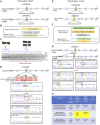CRISPR/Cas9-based targeted genome editing for correction of recessive dystrophic epidermolysis bullosa using iPS cells
- PMID: 31818947
- PMCID: PMC6936361
- DOI: 10.1073/pnas.1907081116
CRISPR/Cas9-based targeted genome editing for correction of recessive dystrophic epidermolysis bullosa using iPS cells
Abstract
Recessive dystrophic epidermolysis bullosa (RDEB) is a severe inherited skin disorder caused by mutations in the COL7A1 gene encoding type VII collagen (C7). The spectrum of severity depends on the type of mutation in the COL7A1 gene. C7 is the major constituent of anchoring fibrils (AFs) at the basement membrane zone (BMZ). Patients with RDEB lack functional C7 and have severely impaired dermal-epidermal stability, resulting in extensive blistering and open wounds on the skin that greatly affect the patient's quality of life. There are currently no therapies approved for the treatment of RDEB. Here, we demonstrated the correction of mutations in exon 19 (c.2470insG) and exon 32 (c.3948insT) in the COL7A1 gene through homology-directed repair (HDR). We used the clustered regulatory interspaced short palindromic repeats (CRISPR) Cas9-gRNAs system to modify induced pluripotent stem cells (iPSCs) derived from patients with RDEB in both the heterozygous and homozygous states. Three-dimensional human skin equivalents (HSEs) were generated from gene-corrected iPSCs, differentiated into keratinocytes (KCs) and fibroblasts (FBs), and grafted onto immunodeficient mice, which showed normal expression of C7 at the BMZ as well as restored AFs 2 mo postgrafting. Safety assessment for potential off-target Cas9 cleavage activity did not reveal any unintended nuclease activity. Our findings represent a crucial advance for clinical applications of innovative autologous stem cell-based therapies for RDEB.
Keywords: CRISPR/Cas9 gene editing; iPSCs; recessive dystrophic epidermolysis bullosa; type VII collagen.
Conflict of interest statement
The authors declare no competing interest.
Figures


Comment in
- 26147
References
-
- Moreno A. M., Mali P., Therapeutic genome engineering via CRISPR-Cas systems. Wiley Interdiscip. Rev. Syst. Biol. Med. 9, e1380 (2017). - PubMed
Grants and funding
LinkOut - more resources
Full Text Sources
Miscellaneous

